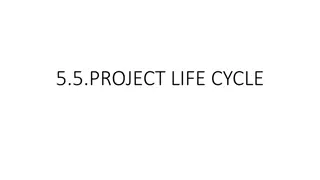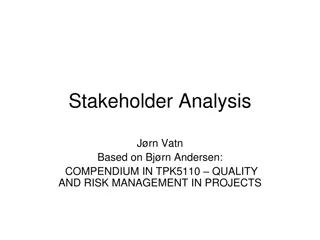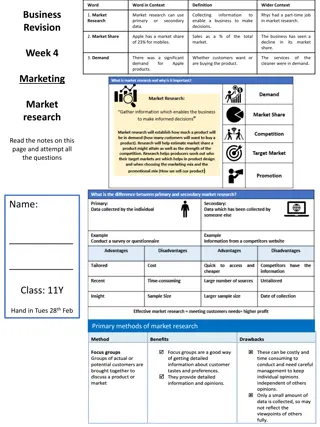Market Analysis (Project Formulation)
This detailed guide covers essential aspects of market analysis and project formulation in entrepreneurship, including feasibility analysis, techno-economic analysis, market demand analysis, steps in market analysis, and factors to consider for market demand analysis. Explore how to assess market demand, gather information, and analyze secondary inputs to make informed business decisions.
Download Presentation

Please find below an Image/Link to download the presentation.
The content on the website is provided AS IS for your information and personal use only. It may not be sold, licensed, or shared on other websites without obtaining consent from the author.If you encounter any issues during the download, it is possible that the publisher has removed the file from their server.
You are allowed to download the files provided on this website for personal or commercial use, subject to the condition that they are used lawfully. All files are the property of their respective owners.
The content on the website is provided AS IS for your information and personal use only. It may not be sold, licensed, or shared on other websites without obtaining consent from the author.
E N D
Presentation Transcript
Market Analysis (Project Formulation) ENTREPRENEURSHIP
Project Formulation Feasibility analysis 1. Techno Economic analysis (Market demand analysis include) 2. Project Design & Network analysis 3. Input analysis 4. Financial analysis 5. Social Cost-Benefit analysis 6. Pre-investment analysis 7.
Market Demand Analysis Analysis of market Demand: Market and demand analysis is concerned with two broad issues What is likely aggregate demand for the product / service? What share of the market will the proposed project enjoy?
Market Demand Analysis Factors to be considered for getting the answers for the above: Patterns of consumption growth Income and price elasticity of demand Composition of the market Nature of competition Availability of substitutes Distribution channels It establishes whether the project is technically feasible or not and whether it offers a basis for the estimation of costs.
Steps in market analysis: Situation analysis and specification of objectives: Talk to customers, competitors, middlemen and others For carrying out market survey spell out the objectives clearly Questionnaire can help gathering the information in a way relevant for forecasting the demand
Steps in market analysis: Collection of secondary inputs: Secondary information is the one which was gathered in some other context and is available readily for the present consideration Primary information is the one, which is collected for the first time to meet the specific purpose on hand. Secondary information forms the basis and starting point for the market and demand analysis. General sources of secondary information:
Steps in market analysis: Collection of secondary inputs: Censes of India, National sample survey reports, Plan reports, India year book, Statistical year book, Economic survey, Guide lines to industries, Annual survey of industries, Publications of advertising agencies, Monthly bulletin of RBI, etc. Annual reports of association of Indian automobile manufacturers Journals of industry associations. The relevance, reliability, accuracy are to be carefully studied in the information available in the secondary information.
Conduct of market survey: Secondary information may not provide a comprehensive basis often thus necessitating gathering primary information through market survey. Census survey: Entire population is covered. It is suitable for intermediate goods, investment goods - where the number is less. Sample survey: A sample of the population is contacted or observed. Inferences are made on the basis of the information gathered from the sample.
Conduct of market survey: Sample survey: Examples Total demand & rate of growth of the demand, Demand in different segments of the market, Income & price elasticity of the demand, Motives for buying, purchasing plan and intentions, Satisfaction with existing goods, Unsatisfied needs, Attitudes towards various products, Distribution trade practices and preferences, Socio-economic characteristics of buyers
Steps in conducting Sample survey: Define the target population Select the sampling scheme and sample size Develop the questionnaire Recruit and train the field investigators Obtain the information as per questionnaire from the sample respondents Scrutinize the information gathered Analyze and interpret the information
Companies use market demand analysis to understand how much consumer demand exists for a product or service. This analysis helps management determine if they can successfully enter a market and generate enough profits to advance their business operations.
Market & Demand Analysis In most cases, the first step in project analysis is to estimate the potential size of the market for the product proposed to be manufactured and get an idea about the market share that is likely to be captured. Given the importance of market and demand analysis, it should be carried out in an orderly and systematic manner.
Market & Demand Analysis The key steps involved in market and demand analysis are as follows. Situation Analysis and Specification of Objectives Collection of Secondary information Conduct of Market Survey Characterization of Market Demand Forecasting Formulation of the Market Plan
What is Market Demand Analysis ? While several methods of demand analysis may be used, they usually contain a review of the basic components of an economic market which are: Market identification Business cycle product niche growth potential competition
MarketIdentification The first step of market analysis is to define and identify the specific market to target with new products or services. Companies will use market surveys or consumer feedback to determine their satisfaction with current products and services. Comments indicating dissatisfaction will lead businesses to develop new products or services to meet this consumer demand. While companies will usually identify markets close to their current product line, new industries may be tested for business expansion possibilities.
Business Cycle Once a potential market is identified, companies will assess what stage of the business cycle the market is in. Three stages exist in the business cycle: Emerging, Plateau Declining. Markets in the emerging stage indicate higher consumer demand and low supply of current products or services. The plateau stage is the break-even level of the market, where the supply of goods meets current market demand. Declining stages indicate lagging consumer demand for the goods or services supplied by businesses.
Product Niche Once markets and business cycles are reviewed, companies will develop a product that meets a specific niche in the market. Products must be differentiated from others in the market so they meet a specific need of consumer demand, creating higher demand for their product or service. Many companies will conduct tests in sample markets to determine which of their potential product styles is most preferred by consumers. Companies will also develop their goods so that competitors cannot easily duplicate their product.
Growth Potential While every market has an initial level of consumer demand, specialized products or goods can create a sense of usefulness, which will increase demand. Examples of specialized products are iPods or iPhones, which entered the personal electronics market and increased demand through their perceived usefulness by consumers. This type of demand quickly increases the demand for current markets, allowing companies to increase profits through new consumer demand.
Competition An important factor of market analysis is determining the number of competitors and their current market share. Markets in the emerging stage of the business cycle tend to have fewer competitors, meaning a higher profit margin may be earned by companies. Once a market becomes saturated with competing companies and products, fewer profits are achieved and companies will begin to lose money. As markets enter the declining business cycle, companies will conduct a new market analysis to find more profitable markets.
Market Planning A marketing plan usually has the following components Current marketing situation Where is your organisation now? Who are your customer groups? What are their needs and requirements? How large and diverse are they? What kinds of products and services do you currently provide? How do you reach your customer groupings? Do you have any competition? What factor/s in your environment has an effect on your organisation?
Market Planning Opportunity and issue analysis (S.W.O.T. analysis). This identifies key issues and opportunities for your organisation and it comprises an analysis of your internal operations Strengths Weaknesses Also those external factors, which effect your organisation Opportunities Threats
Market Planning Objectives. Having identified the key issues affecting your organisation you can make some decisions about future objectives. These guide the development of strategies and action plans. Objectives should meet certain criteria e.g. financial, and marketing which will be customer focused. They should be clearly stated, measurable and listed in order of importance They should be attainable and consistent with your organisation's culture.
Market Planning Marketing strategy. This is the game plan that needs to be implemented to achieve the objectives. It addresses the following: Whom are you now targeting? What do you want your position to be in terms of new product/service delivery? Do you want to change your organisation profile and will you need to rebrand your organisation? Will you change the way you promote and advertise yourself? Will there be any changes in how you reach your customer groupings? Any changes in staff? Is there a need for more research?
Market Planning Action program. This describes:What will be done When will it be done? Who will do it? How much will it cost
Market Planning Budget and controls. The Budget is essentially a cash flow statement and profit/loss statement to support the marketing plan Control mechanisms and procedures should be established to monitor the progress of the plan to determine if anything needs changing. It would include a contingency plan in case something adverse should happen.
Demand Forecasting After gathering information about various aspects of the market and demand from primary and secondary sources. An attempt may be made to estimate future demand. These may classified in three categories as shown Qualitative Methods Time series projection Methods Causal Methods Jury of executive opinion Method Chain ratio Method Consumption level Method 1. 2. 3. 4. 5. 6.
Market Characterisation Based on the information gathered from secondary sources and through the market survey, the market for the product or service to be offered may be described in terms of the following: Effective demand on the past and present Breakdown of demand Price Methods of distribution and sales promotion Consumers Supply of competition Government Policy 1. 2. 3. 4. 5. 6. 7.
Situational analysis & specification of objectives In order to get a feel of the relationship between the product and its market, the project analyst may informally talk to customers competitors, middlemen and other in the industry. Where and how to market the new product/service the objectives of the market and demand analysis in this case may be to answer the questions.
Situational analysis & specification of objectives Who are buyers of the new product/service? What is the current demand for the new product/service? How is demand distributed temporally and geographically? What is the breakup of demand for the new product/service of different sizes? What price and warranty will ensure its acceptance? What channels distribution is most suited for the new product/service? What trade margins will induce distributors to carry it? What are prospects of immediate sales?

 undefined
undefined





























